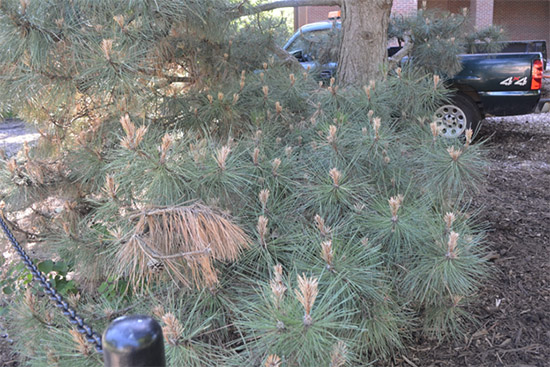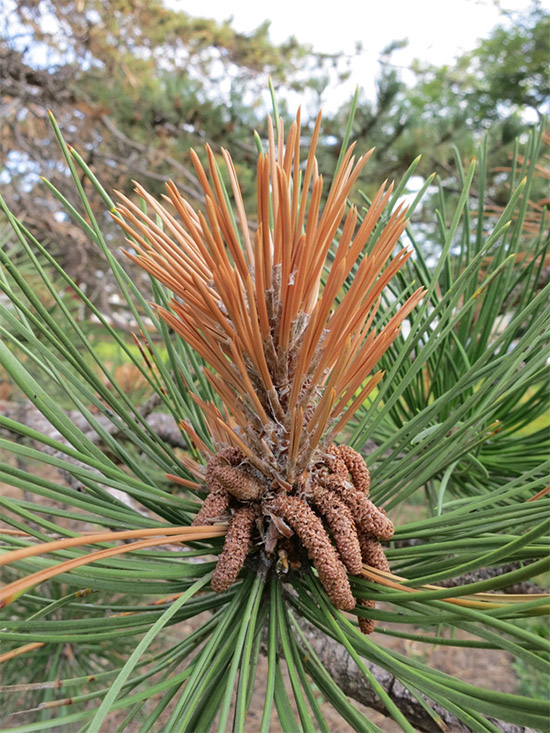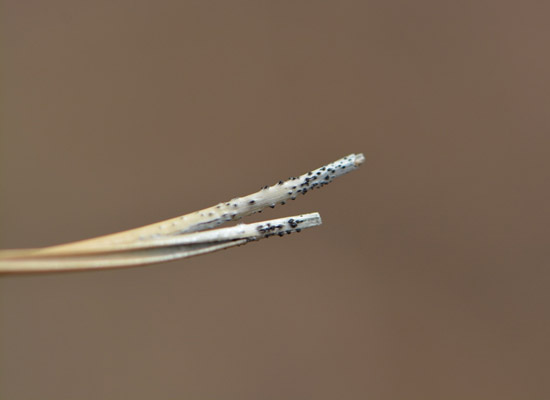Issue 9, June 20, 2016
Diplodia Blight
Austrian pines are showing symptoms of Diplopia (Sphaeropsis) tip bight. This disease is prevalent in Illinois, especially in years when we have lengthy, cool, and wet spring weather. Diplodia is a fungal disease that mainly affects two- or three-needled pine species. White pine, Spruce, fir, Douglas fir, and other evergreen species are also potential hosts, but are less affected by the disease.
The most characteristic symptom is the blighting of all needles at the branch tips. Affected needles are killed mid-development, resulting in a stunted, straw or tan colored appearance. Diseased needles remain attached to the shoots (Photo 1 & Photo 2). Diplodia symptoms share similarities to other needle blights and disorders, and may require microscopic observation to confirm the disease. However, for many infections, field diagnosis of Diplodia tip blight can often be achieved by observing the black, pinhead-sized fungal fruiting bodies at the base of blighted needles (Photo 3). Fruiting bodies can also be found on cones and bark tissues. As you are scouting, be aware that the fruiting bodies may not appear on freshly killed shoots, but should appear on shoots killed during the previous spring. Suspect needles can also be placed in a plastic bag for 24 to 48 hours with a damp paper towel to help elicit fruiting bodies.

Photo 1. Numerous Austrian pine shoots blighted by Diplodia. (Urbana, IL June 2016)

Photo 2. Close-up of a young shoot killed by Diplodia tip blight

Photo 3. Black fungal fruiting bodies of Diplodia.
The fungi that cause Diplodia blight are well known for their ability to take advantage of weakened or stressed plants. On stressed plants, infections may progress from diseased shoots to larger branches, resulting in resinous cankers, death of mature needles, and death of branches.
Cultural controls play an important role in disease management. Diseased branches, branch tips, and cones all contribute to future infections. To reduce disease inoculum, prune and remove any dead wood, diseased branches, needles and cones. To reduce the spread of the disease, prune only when foliage is dry. Sterilize pruners with 10% household bleach or 70% rubbing alcohol, especially before pruning healthy pine trees. Prune diseased branches 6 to 8 inches below the point where they are obviously infected. Alleviate any stress to affected pine trees. This should include mulching and watering during periods of drought.
Fungicide won’t be beneficial at this point, but can applied next spring to help protect developing needles. Fungicides containing the active ingredients chlorothalonil, copper, mancozeb, myclobutanil propiconazole, or thiophanate-methyl are labeled for use to manage Diplodia Tip Blight. The sprays should be applied three times in a season to achieve good control: when buds begin to swell and elongate, just before the new needles emerge from the sheath, and 10 to 14 days later. For the remainder of this season, concentrate on cultural management options. (Travis Cleveland)
Author:
Travis Cleveland